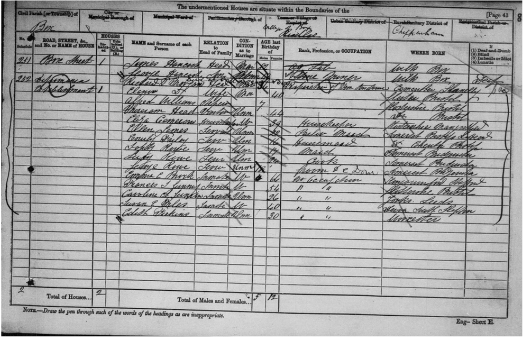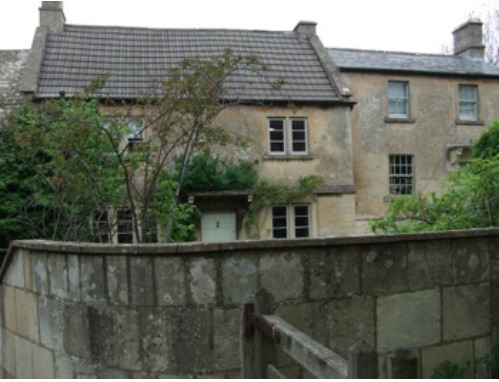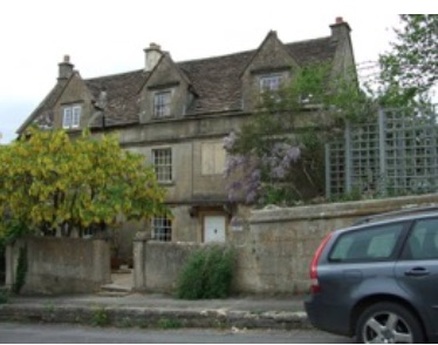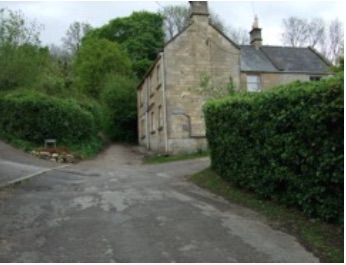
Female Dipsomania Establishment in Box
David Ibberson
July 2015
Based on the original research of Peter Ford
Photos courtesy David Ibberson
Left: Extract of the 1881 census courtesy Ancestry.com
David Ibberson
July 2015
Based on the original research of Peter Ford
Photos courtesy David Ibberson
Left: Extract of the 1881 census courtesy Ancestry.com
Introduction
Should you care to read the tabloid press you will find that few days pass without some celebrity going into rehab for alcohol or drug addiction. Such addictions have afflicted us since time immemorial but what has changed is public attitude. In the late Victorian period women who were habitual drunkards caused society great concern because these women did not conform to Victorian expectations of the role they should have in family life. Society could not decide if they were feeble-minded, mentally ill, driven by a vice or a disease, or genetically inclined. Whatever the cause, Victorians considered society needed protection from themselves and the nation's children.
You might, however, be surprised to learn that, for a brief period in Victorian times, Box boasted a centre for women diagnosed with Dipsomania, a form of alcoholism where sufferers have bouts of drinking lasting several days or even weeks. As you might expect, the Box institution wasn’t a charity, only those with money could benefit. The establishment in Box may be a consequence of the Inebriates Act of 1879, which encouraged habitual inebriants who voluntarily requested treatment to be admitted to a licensed institution set up for the purpose, subject to self funding or support from a sponsor.
Should you care to read the tabloid press you will find that few days pass without some celebrity going into rehab for alcohol or drug addiction. Such addictions have afflicted us since time immemorial but what has changed is public attitude. In the late Victorian period women who were habitual drunkards caused society great concern because these women did not conform to Victorian expectations of the role they should have in family life. Society could not decide if they were feeble-minded, mentally ill, driven by a vice or a disease, or genetically inclined. Whatever the cause, Victorians considered society needed protection from themselves and the nation's children.
You might, however, be surprised to learn that, for a brief period in Victorian times, Box boasted a centre for women diagnosed with Dipsomania, a form of alcoholism where sufferers have bouts of drinking lasting several days or even weeks. As you might expect, the Box institution wasn’t a charity, only those with money could benefit. The establishment in Box may be a consequence of the Inebriates Act of 1879, which encouraged habitual inebriants who voluntarily requested treatment to be admitted to a licensed institution set up for the purpose, subject to self funding or support from a sponsor.
Richard Morgan, Proprietor
The proprietor in the 1881 census was Richard Morgan, a 36 year old chemist from Llanelli, who lived in the establishment with his wife, Eleanor, and his nephew, William. They had a rather large household with five servants and five others described as inmates. It is interesting to note that Richard was the only adult male. None of the inmates was local, which might suggest that they were sent away to avoid any embarrassment or shame to their relatives .
We know a little about Richard Morgan's background. In 1851 his father, David, was working as a licensed victualler, so he may well have witnessed the devastating effect of alcohol addiction at first hand. Ten years later David records his occupation as Pastor for the Borough of LLanelli and in 1871 as a house proprietor in LLanelli.
Inmates of Box Street
In 1881 the women confined in the Dipsomania Establishment were:
The proprietor in the 1881 census was Richard Morgan, a 36 year old chemist from Llanelli, who lived in the establishment with his wife, Eleanor, and his nephew, William. They had a rather large household with five servants and five others described as inmates. It is interesting to note that Richard was the only adult male. None of the inmates was local, which might suggest that they were sent away to avoid any embarrassment or shame to their relatives .
We know a little about Richard Morgan's background. In 1851 his father, David, was working as a licensed victualler, so he may well have witnessed the devastating effect of alcohol addiction at first hand. Ten years later David records his occupation as Pastor for the Borough of LLanelli and in 1871 as a house proprietor in LLanelli.
Inmates of Box Street
In 1881 the women confined in the Dipsomania Establishment were:
|
Emma Brock aged 66, widow
Born in Worcester. She had independent means and prior to entering the Dipsomania Establishment lived in a boarding house in Kings Winford, Worcester. No trace of her could be found after 1881. Frances L Gurney aged 54, widow Frances was born in Bristol but in 1851 we find her living in Saint Peters Port, Guernsey, with her husband John and three children. John had no occupation but was recorded as an annuant in receipt of a pension. By 1861 Frances was a widow living in Davenport with her children and two servants but by 1871 Frances was living alone in a boarding house in Paddington. Her children, three daughters, may well have married. After 1881, the trail is lost. Caroline B Jenkins aged 26, unmarried Other than the fact that she was born in Leeds, nothing is known. Susan E Miles aged 40, spinster Susan was born in Slapton, Devon. In 1871 she was living in Saint Germains, Cornwall, with her cousin, William Paige. William was farming 400 acres and given he has five servants he appears financially secure. However, Susan did have an annuity and was to some extent independent. Edith Perkins aged 30 Edith was born in Worcester and in 1861 was living with her family. Her father, Abraham, was recorded as being of independent means. On leaving Box she returned to her family but by 1901 she was living with her brother's family in Finchley, Middlesex, employed as a typist. Edith’s time in Box appears to have been a success. |
Other women may well have been treated at Box's Dipsomania Establishment but on the day of the census only five were in residence. I use the word treated advisedly, the women were described as inmates, which might suggest they were kept confined, cold turkey to cure their supposed illness.
Where was the Establishment?
The census of 1881 in Box appears to be slighlty haphazard. At first glance the building appears to be in Box Street but, in fact, Box Street never existed. The typed header page for each family in the area of the Dipsomania Establishment were recorded on the Box Sheet (badly written).
The location of the Dipsomania Establishment remains elusive but there are some clues. The census page is recorded in the location of Box Village, meaning the central area. To try to locate the building we need to look at homes surrounding the Establishment. Even then, we must assume the census numbering system is sequential, that is for example that the Dipsomania Establishment numbered 252 in the census is the home next to James Hancock numbered 251.
The census of 1881 in Box appears to be slighlty haphazard. At first glance the building appears to be in Box Street but, in fact, Box Street never existed. The typed header page for each family in the area of the Dipsomania Establishment were recorded on the Box Sheet (badly written).
The location of the Dipsomania Establishment remains elusive but there are some clues. The census page is recorded in the location of Box Village, meaning the central area. To try to locate the building we need to look at homes surrounding the Establishment. Even then, we must assume the census numbering system is sequential, that is for example that the Dipsomania Establishment numbered 252 in the census is the home next to James Hancock numbered 251.
Could the property above left be No 252? Whilst a long shot, Rookery Nook, Hazelbury Hill, fits into the numbering sequence and dates from the late 1700s or early 1800s. It seems too small to accommodate thirteen people but other than one male, Richard Morgan, and a boy, all residents were female. Box's Establishment was not a high-status household so rooms would be shared. Alternatively it may have taken in the little rank of cottages to the right.
Or is it Amberley or Cobden (above right)? They were previously called 1 and 2 Townsend Villas and date from the 1600s or early 1700s, so they were in existence at the time. Any suggestion or evidence to answer the vexing question as to the location of the Dipsomania Establishment would be welcomed. None of these house names is given in the census.
Or is it Amberley or Cobden (above right)? They were previously called 1 and 2 Townsend Villas and date from the 1600s or early 1700s, so they were in existence at the time. Any suggestion or evidence to answer the vexing question as to the location of the Dipsomania Establishment would be welcomed. None of these house names is given in the census.
Other Properties
At another property in the same area lived James Vezey, soap and candle maker, in the house at entry number 250. And a few doors on from the Dipsomania Establishment, at entry number 254, was William Holder who was recorded in the last house in the central village. This house would appear to be Hazelbury Cottage (below), property 254.
At another property in the same area lived James Vezey, soap and candle maker, in the house at entry number 250. And a few doors on from the Dipsomania Establishment, at entry number 254, was William Holder who was recorded in the last house in the central village. This house would appear to be Hazelbury Cottage (below), property 254.
|
At entry 240 were George and James Eyles, shoemakers, in the last house on the census marked Box Sheet and in 239 the first house on Quarry Hill.
We do know from the 1891 census that James Vezey lived in the proximity of the Soap and Candle Factory, so does this indicate that the location of the Dipsomania Establishment was in the area where Quarry Hill, The Ley and Hazelbury Hill meet? Is it possible that the building was on Hazelbury Hill, given that the cottage at the top might be 254 and the end of the village? This would perhaps make Rookery Nook the most likely candidate. |
The inmates were not grand ladies, so it is possible that
within the cluster of houses near the bottom of Hazelbury Hill, we
might find the location of the Dipsomania Establishment. For my part, I
remain unsure and accept we may never know.
Conclusion
One suspects that Edith Perkins was one of the few who managed to overcome her addiction. Many others either died on the streets or ended their days in a workhouse or mental asylum. The Victorian view was that a drink problem was a condition of the working class, often the cause of dissolute lifestyle or lack of religious morality. The fight against this was often led by religious or moral groups such as the Temperance Movement, the Band of Hope and the great social reformers such as William Booth founder of the Salvation Army.
But behind closed shutters the middle classes were not immune. They too became addicted but were able to keep their condition hidden in institutions such as Box's Dipsomania Establishment. The background of Richard Morgan suggests that his family may have been Dissenters in Llanelli. On leaving Box in the 1880s we find Richard as proprietor of Wellington House, Clevedon, Somerset, which he describes as a sanatorium although someone has written alongside boarding house. Was this a similar medical establishment?
Conclusion
One suspects that Edith Perkins was one of the few who managed to overcome her addiction. Many others either died on the streets or ended their days in a workhouse or mental asylum. The Victorian view was that a drink problem was a condition of the working class, often the cause of dissolute lifestyle or lack of religious morality. The fight against this was often led by religious or moral groups such as the Temperance Movement, the Band of Hope and the great social reformers such as William Booth founder of the Salvation Army.
But behind closed shutters the middle classes were not immune. They too became addicted but were able to keep their condition hidden in institutions such as Box's Dipsomania Establishment. The background of Richard Morgan suggests that his family may have been Dissenters in Llanelli. On leaving Box in the 1880s we find Richard as proprietor of Wellington House, Clevedon, Somerset, which he describes as a sanatorium although someone has written alongside boarding house. Was this a similar medical establishment?
Sources
Ancestry.com
Temperance movement http://en.m.wikipedia.org /wiki/Temperance-movement
Christine Mary Crabbe, On the Borderland of Insanity: Women, Dipsomania and Inebrity, 2014, PhD Thesis, University of West of England, http://eprints.uwe.ac.uk/23418/
Ancestry.com
Temperance movement http://en.m.wikipedia.org /wiki/Temperance-movement
Christine Mary Crabbe, On the Borderland of Insanity: Women, Dipsomania and Inebrity, 2014, PhD Thesis, University of West of England, http://eprints.uwe.ac.uk/23418/


